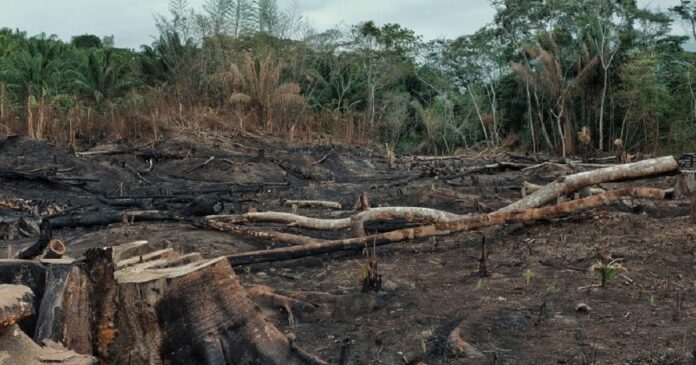We continue our series on cocoa production in Africa with land preparation for cocoa farming. This series is meant to provide all the information you need to start and succeed in cocoa production.
We have already looked at;
- Cocoa Production in Africa: Overview with Key Facts and Figures
- What Are The Major Challenges in Cocoa Production in Africa?
- Good Cocoa Nursery Establishment and Management
- Good Site Selection for Productive and High-Yielding Cocoa Farming
- Types Of Cocoa, Characteristics and Parts Of the Cocoa Tree
Now, let us look at effective land preparation for cocoa farming in Africa.
Clear the land between December and February before the rainy season. Be selective when removing large trees. Some of these trees may be undesirable and this includes those trees that harbour the cocoa swollen shoot virus. Remove such trees and leave about 15-18 desirable trees per hectare to provide permanent shade.
Do not burn after clearing. Leave the debris to decay and improve the soil. Burning exposes the soil to erosion, loss of organic matter, leaching and other disadvantages. Read more about why we do not recommend slash and burn.
Lining and Pegging
After properly clearing the land and removing all undesirable trees, it is important to line and peg your field before planting the cocoa.
We assume that at this stage you have already established your cocoa nursery.
This activity of lining and pegging your field will make sure that you utilise the space on your land very well. It also helps you to carry out husbandry activities much easier. It helps to increase yield also, therefore increasing income.
During lining and pegging, the position of the pegs will be the position where the cocoa seedlings will be planted. Get a cocoa expert or someone who is familiar with the process of lining and pegging to help you.
Spacing
Plant at a spacing of 3.0m x 3.0m, or 10ft x 10ft if you are using hybrid cocoa seedlings. In this case, you will have 1,111 trees per hectare or 435 trees per acre. Proper spacing allows for less competition for space, sunlight, water, and nutrients, so the trees look healthy and high yielding. It is also easier to do weeding, spraying, fertilizer application, harvesting and other activities. The opposite is the case when the seedlings are planted close to each other.
Shade Establishment
As a young cocoa seedling transplanted into an open field, shade helps it to survive and grow well. This is why you have to make sure there are already plants that are established to provide shade.
Establishment of Temporary Shade
For temporary shade, you can grow food crops like plantain and cocoyam at 3m x 3m and 1m x 1m respectively. This will provide enough shade for the young cocoa plant. Plant the plantain 1.5m away from the cocoa plant and the cocoyam 1m away from the cocoa.
Do well to plant these food crops in line so they do not impede farm operations as stated before.
You can also plant fruit trees like pawpaw at 3m x 3m to provide temporary shade. Also, you can use fast-growing trees like Glyricidia at a spacing of 6m x 6m to provide temporary shade.
These shading plants come with some benefits besides shading the young plants. They serve as food sources for the household, they can generate income, and serve as weed control among others.
Establishment of Permanent Shade
In the case where you do not have enough desirable permanent shade trees on the land during land preparation, you can go for Termi nalia ivoriensis and Albizia coriaria from the Forestry Commission and plant them for permanent shade.
Make sure you have about 15 to 18 trees per hectare.
We conclude this piece with some examples of desirable and undesirable shade trees.
Desirable Shade Trees
-
- Entandrophragma utile (Utile)
- Terminalia ivoriensis (Emire)
- Terminalia superb (Ofram/Framo)
- Albizia coriaria (Awiemfuo samina)
- Entandrophragma angolense (Edinam, cedar)
- Funtumia elastica (Ofuntum)
- Alsonia boonei (Nyamedua),
- Pycnanthus angolensis (Otie)
- Milicia excelsa (Odum)
- Entandropragma angolense (Sapele)
- Tieghemella heckelli (Baku/Makore)
- Entandrophragma utile (Utile)
- Khaya grandifoliola/ivoriensis/anthotheca (Mahogany)
Undesirable Shade Trees
-
- Ceiba petandra (Onyina)
- Cola gigantea (Watapuo)
- Canthium glabriflorum (Gyapam, Nteteadupon)
- Chlamydocola chlamydantha (Kra bise, Osonkrobia, Penamfera)
- Blighia sapida (Akyewobiri)
- Adansonia digitata (Odadee)
- Carapa procera (Kwakuo bise)
- Musanga cecropioides (Odwuma)
- Lecaniodiscus cupanoides (Dwindwera)
- Myrianthus arboreus (Nyankuma)


